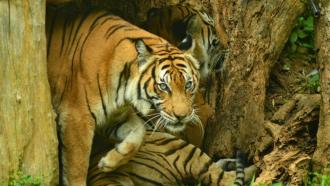![A rhesus macaque from Andhra Pradesh [Image Credits: J.M.Garg] Do differing opinions affect the management of human-animal conflicts?](/sites/researchmatters/files/styles/large_800w_scale/public/monkey29jul.jpg?itok=mT_fpOQf)
A rhesus macaque from Andhra Pradesh [Image Credits: J.M.Garg]
People see human-animal conflicts as a fight between two species on opposing sides. However, in reality, the human aspect also has multiple dimensions. In some cases, there are two groups—the affected public—and the forest department staff, who manage and mitigate it; in others, more such groups. One of the frequent human-animal conflicts is that between humans and monkeys, especially the rhesus macaque, whose population is widespread in many cities. Now, a study by researchers shows that differences in people's opinions on mitigating such conflicts could instead be adding to the conflict.
In their study, Dr Shaurabh Anand and Dr Sindhu Radhakrishna from the National Institute of Advanced Studies, Bengaluru, evaluated the perceptions of wildlife management personnel involved in mitigating human-monkey conflict in Himachal Pradesh. Their findings, published in the journal Ambio, show that differing opinions about how to manage and reduce this conflict could influence mitigation.
During a project that explored human-monkey conflict, the researchers found that their conversations with farmers and forest department personnel showed another dimension they could explore.
"These discussions reinforced our views that the impacts of human-human conflict on conflict mitigation would be interesting to pursue," shares Dr Radhakrishna.
Hence, they began to look at varying perceptions on this issue among the people in the forest department.
The researchers gathered the views of the staff, through surveys, on the intensity and causes of human-monkey conflicts. They first interviewed 32 District Forest Officers, who said that monkey-human conflict was more prevalent in rural areas. They then questioned 135 forest personnel from two divisions about the same issue.
Interestingly, about 70% of participants of the second survey stated that the primary cause of human-monkey conflicts in rural areas was a lack of natural food resources. Besides, an increase in the macaque population, habitat destruction, and people feeding macaques played a role. In urban areas, almost 80% said humans feeding macaques was the primary cause, followed by improper food waste disposal. Those in the upper-level management felt that sterilisation and culling, which are currently followed, worked in mitigating it. However, those in the middle-level criticised sterilisation and the lower-level was against killing because of religious beliefs.
The study found a wide range of solutions proposed by the participants in mitigating conflicts. About half of them suggested increasing food resources in the wild—a suggestion that four out of five people felt would help. Other ideas included translocation, sterilisation, and culling of problematic individuals. A little over 70% criticised culling, and over 50% were unsure if sterilising monkeys would work.
People in the lower and middle management identified translocation and lack of wild food resources as the primary causes of conflict in rural areas. The upper management attributed this to the growth in the macaque population. While those in the lower positions felt that planting trees would be useful to resolve such conflicts, the middle and upper-level employees favoured culling.
The study shows that the personnel in the forest department hold multiple social identities. In addition to being a part of the department itself, they are also a part of the broader farmer community. Having different social identities can cause differences in personal and public views. “Skepticism of lower management level personnel regarding the efficacy of the measures has the potential to reduce their involvement and commitment in the implementation of the measure and would thereby affect its overall outcome”, adds Dr Radhakrishna. When the researchers analysed the sentiments of the survey responses, they found that forest department personnel had a negative view towards laypeople. Presumably, this prejudice is because the public feeds monkeys, intrude in their habitat and both oppose culling. Interestingly, the forest department staff were more positive towards macaques, compared to people!
"The intensity of human-wildlife conflict issues are mediated by both—the species involved and the socio-cultural dynamics of the human stakeholders. Studies from other regions would help provide a greater understanding of the complexities in this under-explored issue", concludes Dr Radhakrishna.
This article has been run past the researchers, whose work is covered, to ensure accuracy.






